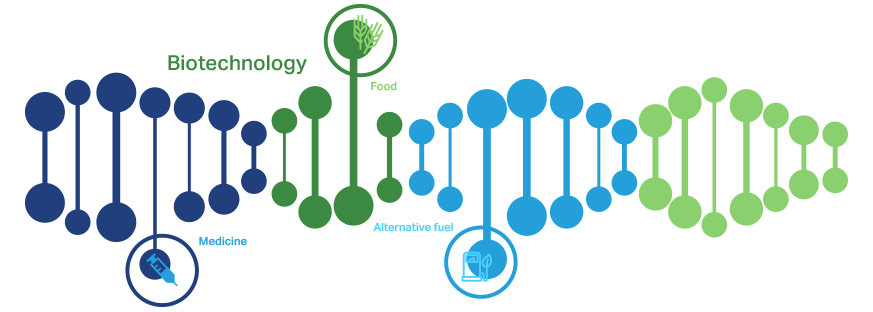
What are Life Sciences?
The simplest way to define life sciences is the study of living organisms and life processes.
At NCBiotech, we see it as science involving cells and their components, products and processes. Biology, medicine and agriculture are the most obvious examples of the discipline. However, in recent years, a convergence is underway that requires a multi-discipline approach. For example, biologists, chemists, and robotics and automation engineers will work together to develop new solutions.
What is Biotechnology?
Biotechnology, the most prominent component of the life sciences, is a toolbox that leverages our understanding of the natural sciences to create solutions for our world's problems. We use biotechnology to grow food to feed families and to make medicines and vaccines to fight diseases. We even turn to biotechnology for new innovations, such as leveraging plants to manufacture medicines and create alternative fuels.

How Biotechnology Works
Biotechnology is grounded in the pure biological sciences of genetics, microbiology, animal cell cultures, molecular biology, embryology and cell biology. Biotechnology discoveries are intimately entwined in the life sciences industry sectors for development in agricultural biotechnology, biomanufacturing, human health, precision medicine and medical devices and diagnostics. For example, biomedical researchers use their understanding of genes, cells and proteins to pinpoint the differences between diseased and healthy cells. Once they discover how diseased cells are altered, researchers can more easily develop new medical diagnostics, devices and therapies to treat diseases and chronic conditions.
History of Biotech
Biotech has led us to the greatest innovations. Since 1984, North Carolina has nurtured its life sciences assets, firmly establishing itself as a leading U.S. life sciences hub characterized by steady growth of companies and talent statewide. Diverse, specialized subsectors, serve a variety of needs globally. The state pivoted from its deep roots in agriculture and furniture manufacturing to focus on biotechnology.
In the early 2000s, as more biotech products gained regulatory approval, companies expanded production capacity. This led to the state's growing demand for skilled biopharmaceutical manufacturing workers. Workforce development programs continue to fuel our state's talent pool. This talent pool, in turn, helps to recruit new life sciences companies and supports local company growth.
The Future of Biotech
Today, North Carolina is home to more than 830 life sciences companies, a talent pool of 75,000 skilled workers and an additional 2,500 companies that support the sector. According to the 2022 TEConomy Report, despite the COVID-19 pandemic and economic challenges, the state's life sciences growth has outpaced national growth, placing itself among the top-tier life sciences hubs.
North Carolina has long invested in scientific infrastructure to fuel innovation. With three top-tier research universities, scientific innovations are seeding new spinouts and advancing technologies to the next level.
Through our strengths in research and development, talent, training and scientific infrastructure, North Carolina will remain at the forefront of biotechnology and life sciences.
